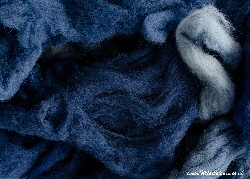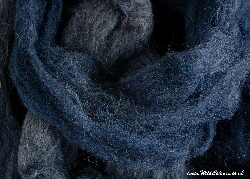Urine Vat (or Sig Vat) for Indigo and Woad
|

|
|
White Jacobs wool dyed with Indigo using the Urine vat
|
|

|
|
Grey Jacobs wool dyed with Indigo using the Urine vat
|
|
Making a urine vat will give you the satisfaction of reproducing a low cost method used for thousands of years. The urine vat works at a lower pH as well as at a lower temperature than other indigo vats. You can use this vat for cotton and linen, and it is ideal for dyeing wool as the fibres are unlikely to felt. Wool and silk can be kept in the vat for a few hours or overnight, allowing better penetration of the dye. Another advantage of the urine vat is that it is easier to build darker shades of blue.
This vat needs a bit of warmth to get going, but once working, the vat only needs little attention. If the temperature is right, with time, bacteria break down the urea and other components of the urine into ammonia. It is the ammonia that gives the pungent smell to stale urine. The bacteria remove the oxygen, whilst ammonia makes the vat alkaline, the two requirements of an indigo vat. The urine vat has a strong smell and is best made outside during the summer. If you keep the vat in a bucket with a good lid, the smell will only be noticeable when you need to open the lid, which will be a very short time. [Be diplomatic when dealing with a urine vat and avoiding annoying other members of the household or your neighbours…]
Using the Urine vat for Woad or Indigo Dyeing
1. Collect enough urine to nearly fill a five litre container with a good lid. Leave enough space in the container for adding the fibre later on, otherwise the urine will overflow.
a. The urine does not have to be collected all in one day, you can collect it over a week or longer if necessary. If you are a woman, you may find a portable female urinal useful.
b. Collect a couple more litres of urine in a second container, as you will need extra urine to top up the vat and to wet the fibres beforehand.
c.Most types of urine will do, however urine collected first thing in the morning may have more nutrient; whilst urine collected after a lot of beer or tea drinking may have less nutrient. Avoid urine from people who are on medication.
d. Make sure you store the urine in a well-marked container and keep the lid on.
e. Allow the urine to become stale, which takes two to three weeks depending on the weather.
2. Weigh 15 grams (about three teaspoons) of indigo (or woad) powder and place it inside a piece of fine muslin. Tie it closed with thread and suspend it in the container with the urine. The thread should be fine enough to allow you to close the lid of the container.
3. Place the urine container in a warm place but make sure it does not get too hot. I place my bucket in a cold frame in a sunny corner of the garden. If you don’t have a cold frame, try putting a black dustbin upside down over the urine container. The urine vat needs to be between 30°C and 35°C to get started, after that it works in temperatures as low at 18°C.
4. Every day, poke the indigo bag gently with a stick to allow a little more indigo into the vat. Alternatively, you could rub or squeeze the muslin bag.
5. Depending on the temperature the vat should change in colour from blue to greenish yellow and develop a fine scum in two to four days. If the liquid is still blue or dark green there is unreduced indigo and the vat is not ready. If you are not sure, you can test the vat by leaving a scrap of cotton fabric in the vat overnight, taking the cotton out the next morning and checking the colour.
6. Check the pH, which should be about 9, and add more urine if necessary. If the pH remains low, add 1 teaspoon of soda ash.
7. When the vat looks ready you can start dyeing. Soak your well-washed fibre in the second bucket of urine for an hour before adding it to the indigo vat.
8. Leave the fibre in the indigo vat overnight. In the morning, take the fibre out of the vat. I use a stick to ‘fish’ the wool out and an old sieve to ‘catch’ the wool. Then I stand the sieve over a container to collect the dripping urine, which I store in another bucket.
9. Let the fibre air for 5 to 10 minutes. There will not be a dramatic colour change from yellow to blue as in other indigo vats. In the first dip, the wool will be pale blue, but with more dippings the colour will soon darken.
10. After the fibre has aired, put it back in the vat.
11. Repeat this procedure every morning and evening until the fibre is as dark as you want. Five to ten days will probably be enough.
12. Keep re-dipping the fibre in the vat until the fibre is the required shade of blue. Keep the vat topped up with urine and add more indigo when necessary.
13. Rinse the fibres well. The smell of urine will eventually disappear.
Top of Page
Tips for Dyeing with a Urine Indigo vat
• If the weather is cold you could put your container inside a greenhouse. However, the smell will be quite strong as you will be working in an enclosed space.
• Another alternative to increase the temperature of the vat is to half bury the bucket, as the soil keeps the warmth longer than the air. If you are using a cold frame, burying the bucket also allows you to use a larger bucket.
• If your vat is not working properly, you may need to add more nutrient. You could try adding a teaspoon of ground madder or 3 slices of over ripe banana to feed the bacteria.
• If you find the smell of the dyed fibre airing too unpleasant, you can oxidise the fibre in a bucket full of clean water, and swish it about for a bit. Oxidising in water reduces some of the smell. The water however, will introduce oxygen, and it is a good idea to soak the wool again in the spare urine bucket before returning it to the vat.
• Ideally try to have two urine vats and use them alternately, so that one has time to recover while the other is being used for dyeing.
Top of the page
|